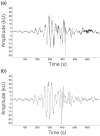Male courtship vibrations delay predatory behaviour in female spiders
- PMID: 24356181
- PMCID: PMC3867958
- DOI: 10.1038/srep03557
Male courtship vibrations delay predatory behaviour in female spiders
Abstract
During courtship, individuals transfer information about identity, mating status and quality. However, male web-building spiders face a significant problem: how to begin courting female spiders without being mistaken for prey? Male Argiope spiders generate distinctive courtship vibrations (shudders) when entering a female's web. We tested whether courtship shudders delay female predatory behaviour, even when live prey is present in the web. We presented a live cricket to females during playbacks of shudder vibrations, or white noise, and compared female responses to a control in which we presented a live cricket with no playback vibrations. Females were much slower to respond to crickets during playback of shudder vibrations. Shudder vibrations also delayed female predatory behaviour in a related spider species, showing that these vibrations do not simply function for species identity. These results suggest that male web-building spiders employ a phylogenetically conserved vibratory signal to ameliorate the risk of pre-copulatory cannibalism.
Figures


Similar articles
-
Short and fast vs long and slow: age changes courtship in male orb-web spiders (Argiope keyserlingi).Naturwissenschaften. 2017 Dec 5;105(1-2):3. doi: 10.1007/s00114-017-1527-8. Naturwissenschaften. 2017. PMID: 29209865
-
The influence of vibratory courtship on female mating behaviour in orb-web spiders (Argiope keyserlingi, Karsch 1878).PLoS One. 2013;8(1):e53057. doi: 10.1371/journal.pone.0053057. Epub 2013 Jan 16. PLoS One. 2013. PMID: 23341922 Free PMC article.
-
A meal or a male: the 'whispers' of black widow males do not trigger a predatory response in females.Front Zool. 2014 Jan 17;11(1):4. doi: 10.1186/1742-9994-11-4. Front Zool. 2014. PMID: 24433544 Free PMC article.
-
Dangerous mating systems: signal complexity, signal content and neural capacity in spiders.Neurosci Biobehav Rev. 2014 Oct;46 Pt 4:509-18. doi: 10.1016/j.neubiorev.2014.07.018. Epub 2014 Aug 1. Neurosci Biobehav Rev. 2014. PMID: 25088579 Review.
-
Spider sex pheromones: emission, reception, structures, and functions.Biol Rev Camb Philos Soc. 2007 Feb;82(1):27-48. doi: 10.1111/j.1469-185X.2006.00002.x. Biol Rev Camb Philos Soc. 2007. PMID: 17313523 Review.
Cited by
-
Sex differences in spiders: from phenotype to genomics.Dev Genes Evol. 2020 Mar;230(2):155-172. doi: 10.1007/s00427-020-00657-6. Epub 2020 Feb 12. Dev Genes Evol. 2020. PMID: 32052129 Free PMC article. Review.
-
The shield effect: nuptial gifts protect males against pre-copulatory sexual cannibalism.Biol Lett. 2016 May;12(5):20151082. doi: 10.1098/rsbl.2015.1082. Biol Lett. 2016. PMID: 27194284 Free PMC article.
-
Effects of social information on life history and mating tactics of males in the orb-web spider Argiope bruennichi.Ecol Evol. 2017 Nov 28;8(1):344-355. doi: 10.1002/ece3.3672. eCollection 2018 Jan. Ecol Evol. 2017. PMID: 29321876 Free PMC article.
-
Short and fast vs long and slow: age changes courtship in male orb-web spiders (Argiope keyserlingi).Naturwissenschaften. 2017 Dec 5;105(1-2):3. doi: 10.1007/s00114-017-1527-8. Naturwissenschaften. 2017. PMID: 29209865
-
Female mating rates and their fitness consequences in the common house spider Parasteatoda tepidariorum.Ecol Evol. 2022 Dec 28;12(12):e9678. doi: 10.1002/ece3.9678. eCollection 2022 Dec. Ecol Evol. 2022. PMID: 36590337 Free PMC article.
References
-
- Ord T. J. & Stamps J. A. Species identity cues in animal communication. Am. Nat. 174, 585–593 (2009). - PubMed
-
- Huber B. A. Sexual selection research on spiders: progress and biases. Biol. Rev. 80, 363–385 (2005). - PubMed
-
- Wilder S. M., Rypstra A. L. & Elgar M. A. The importance of ecological and phylogenetic conditions for the occurrence and frequency of sexual cannibalism. Ann. Rev. Ecol., Evol. Syst. 40, 21–39 (2009).
-
- Elgar M. A. & Schneider J. M. Evolutionary significance of sexual cannibalism. Adv. Study Behav. 34, 135–163 (2004).
Publication types
MeSH terms
LinkOut - more resources
Full Text Sources
Other Literature Sources

